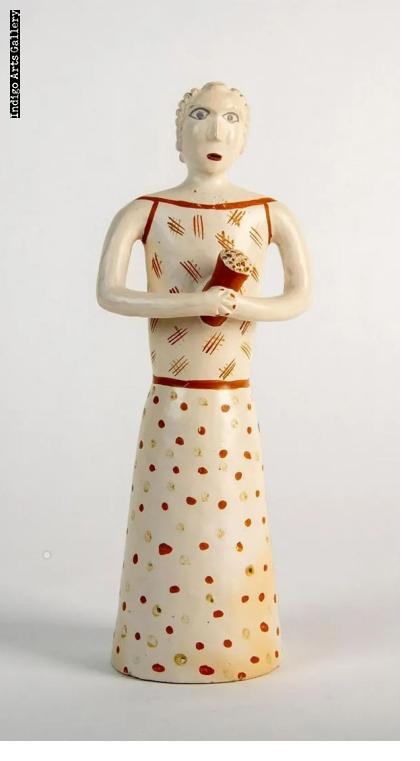A striking form of ceramic sculpture has evolved in the communities of Santana do Aracuaí and Campo Alegre in the Jequitinhonha Valley of Minas Gerais.
Isabel Mendes da Cunha, regarded as the founder of this tradition, grew up making utilitarian pottery with her mother.
This work provided income after she married and was raising her own children. In the late 1970s, when she was in her mid-fifties, Isabel began creating sculptures of human figures that rose out of the water jug form. The heads were made separately to fit into the hollow bodies like lids on jugs. The natural tan ceramic forms were colored with different clay slips. Over the next ten years she perfected the process. Her figures turned into complete, large-scale dolls portraying beautiful women in different situations of everyday life. Many of these are brides, occasionally accompanied by a male groom. By the 1980s, Isabel's dolls were being acquired by enthusiastic folk art collectors.
Isabel was generous about sharing her knowledge and techniques with anyone who wished to learn to make the ceramic figures. This led to a doll movement in her region of the Jequitinhonha Valley. Foremost among her students were Isabel's own children, their spouses, and her grandchildren.
She also influenced a group of talented women potters in the community of Campo Alegre, such as Jacinta Francisca Xavier and Aparecida Gomes Xavier. The style of their figures is characterized by thin arms, and the separate heads include collars that fit over the neck of the vessel.
Another talented folk artist from Campo Alegre is Maria José
Gomes da Silva (Zézinha) who has developed her own style of doll that is more like Isabel's figures but with the head attached to the body. Maria uses black clay that turns white when fired.
(Above text from "Brasil & Arte Popular" exhibit at Museum of International Folk Art, Santa Fe, NM, 2014 - 2015)

